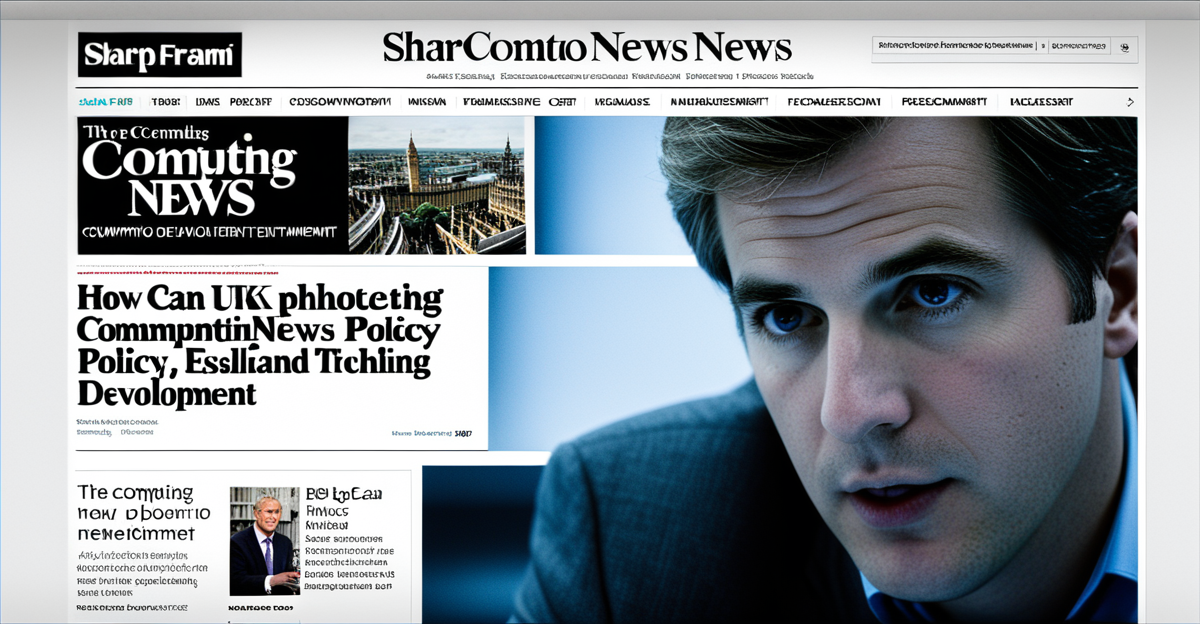Mechanisms by Which UK Computing News Influences Policy Development
Understanding how media influence shapes UK government policy starts with recognizing the role of news coverage in setting the policy agenda. When computing news highlights urgent issues—such as cybersecurity breaches or privacy violations—it draws public attention and compels policymakers to respond. This agenda-setting function directs limited governmental focus toward technology challenges deemed most pressing by the public and media.
Media narratives create clear pathways to policymaker attention. Journalists often frame computing stories to emphasize risks, benefits, or ethical concerns, guiding policymakers’ perceptions and priorities. For example, investigative computing journalism uncovers hidden risks or malpractices, which can trigger regulatory actions or legislative reviews. The UK government frequently reacts to such revelations by proposing new regulations, demonstrating a direct causal link between media reports and policy mechanisms.
Additional reading : What Are the Impacts of Brexit on the UK’s Tech Sector?
These mechanisms are reinforced by the media’s ability to interpret complex technology topics for non-expert audiences, thereby shaping public understanding and offering government officials a distilled view of emerging tech issues. Through this interplay, the media, UK computing news, and policy development engage in a dynamic cycle where transparency and accountability are enhanced through informed coverage and governmental response.
Mechanisms by Which UK Computing News Influences Policy Development
The media influence on UK government policy is significant, notably through news coverage that frames computing issues as urgent concerns. This framing helps set the policy agenda, directing policymakers’ attention toward specific technological challenges. For example, when UK computing news highlights emerging cybersecurity threats, it elevates these risks within government discussions, prompting more immediate regulatory consideration.
Also read : How Might Emerging Technologies Shape the Future of UK Computing?
Pathways from media narratives to policymakers often involve a feedback loop where journalists’ investigations uncover critical issues that might otherwise remain underreported. Investigative computing journalism plays a crucial role in revealing data breaches or ethical dilemmas in AI, shaping regulatory responses indirectly by amplifying public scrutiny. Policymakers then respond to these media-driven agendas by crafting policies or reviewing existing regulations that align with the concerns raised.
Additionally, the UK government frequently monitors computing news to gauge public reaction and expert opinions, which informs its policy mechanisms. This relationship ensures that computing news does not merely influence public discourse but actively contributes to the evolution of technology governance in the UK, highlighting the dynamic interplay between media influence and policymaking.
Real-World Examples of Computing News Shaping UK Policy
News coverage of high-profile data breaches in the UK has directly influenced the government’s approach to data privacy legislation. For instance, when media outlets extensively reported on incidents exposing millions of personal records, public concern surged. This media influence pressured the UK government to strengthen data protection laws, exemplified by updates to the Data Protection Act enhancing user rights and imposing stricter penalties on breaches.
Similarly, national reporting on AI ethics sparked widespread debate, which the UK government could not ignore. Computing news narratives discussed risks such as bias in AI algorithms and lack of transparency, steering policymakers toward developing frameworks for responsible AI use. These discussions led to consultation papers and proposals aimed at regulating AI technologies to ensure ethical standards.
Investigative computing journalism plays a critical role in uncovering hidden tech malpractices. By exposing vulnerabilities or unethical data use behind the scenes, media reports become pivotal policy mechanisms that initiate regulatory reviews or probe government responses. Such investigative pieces have prompted the UK government to reconsider or introduce new tech laws, demonstrating how media influence concretely shapes legislative action.
These case studies illustrate the clear link between computing news, public reaction, and policy development in the UK tech landscape.
Mechanisms by Which UK Computing News Influences Policy Development
Computing news plays a crucial role in the policy mechanisms employed by the UK government by shaping the policymaking process through focused media influence. News coverage often serves as the initial trigger in setting the policy agenda. When the media highlights specific technological concerns—such as cybersecurity vulnerabilities or ethical risks in AI—it directs governmental attention toward these issues, prompting swift policy consideration.
The pathways from media narratives to policymaker action rely heavily on the ability of computing news to frame complex issues in accessible terms. This framing enhances understanding among non-expert officials and the public alike. Investigative computing journalism amplifies this influence by uncovering concealed risks or malpractices, thereby increasing scrutiny and urgency around certain topics. For example, exposing data breaches or questionable AI applications frequently leads to calls for regulatory reform.
Moreover, the media influence extends beyond agenda-setting. It operates through continuous feedback loops where the UK government monitors computing news to gauge public sentiment and expert insights. This ongoing interaction ensures that policy mechanisms remain responsive to emerging tech challenges identified by the media, reinforcing news coverage as a pivotal driver in evolving technology governance.
Mechanisms by Which UK Computing News Influences Policy Development
Media influence plays a pivotal role in shaping UK government policy by setting the agenda through targeted news coverage of computing topics. When computing news highlights urgent issues such as cybersecurity risks or data misuse, it steers governmental focus toward these concerns. This agenda-setting effect ensures that policymakers allocate resources and attention specifically to technology challenges.
Pathways from media narratives to policymaker attention often involve a progression from public awareness to direct governmental response. News outlets distill complex technological issues into accessible stories, increasing public scrutiny and pressing officials to act. Policymakers monitor computing news closely, using it as a gauge for public sentiment and expert input. This interaction reinforces policy mechanisms by ensuring that regulatory actions reflect both media-driven priorities and societal concerns.
Moreover, investigative computing journalism is instrumental in this process. By uncovering concealed technological malpractices or ethical dilemmas, investigative reports compel regulatory bodies to initiate reviews or reforms. Such journalism transforms abstract risks into tangible cases that demand legislative attention. Consequently, the interaction between media influence and policy mechanisms creates a dynamic environment where computing news acts as a catalyst for technological governance reforms by the UK government.
Mechanisms by Which UK Computing News Influences Policy Development
Media influence operates primarily by setting the policy agenda within the UK government, where news coverage pinpoints urgent computing issues requiring attention. This initial agenda-setting function alerts policymakers to problems like cybersecurity flaws or AI ethical dilemmas, focusing governmental resources accordingly. The mechanism hinges on the news’s ability to simplify and frame complex technology stories, making them accessible to decision-makers and the public.
Pathways from computing news to policymaker action often pass through investigative journalism, which uncovers hidden risks or malpractices. These revelations heighten regulatory urgency, compelling the government to respond with policy measures or legislative reviews. Investigative reports on data breaches or unethical AI practices exemplify such media-driven policy mechanisms.
Moreover, the UK government actively monitors computing news to capture public concern and expert commentary, feeding into its ongoing policy mechanisms. This responsive cycle ensures that media narratives continually influence policymaker priorities, reinforcing accountability and transparency. The dynamic interplay among computing news, media influence, and policy mechanisms shapes how the UK government confronts emerging technology challenges, making media coverage a critical driver of technology governance.
Mechanisms by Which UK Computing News Influences Policy Development
Media influence primarily shapes UK government policy by framing computing issues as urgent priorities, thereby setting the policy agenda. News coverage highlights specific challenges—such as cybersecurity incidents or ethical concerns in AI—that demand governmental attention. This agenda-setting role directs limited policy mechanisms toward areas where public and political pressure converge.
Pathways from computing news to policymaker action involve several interconnected stages. Initially, media narratives distill complex technology topics into accessible stories, increasing public awareness and concern. Policymakers, monitoring these developments, respond to the heightened scrutiny by engaging with experts and reviewing existing frameworks. This interaction channels media-driven priorities into concrete policy mechanisms, ensuring alignment between public discourse and governmental focus.
Investigative computing journalism significantly amplifies this effect. By exposing hidden risks or unethical tech practices, such journalism uncovers issues that might evade routine oversight. These revelations prompt regulatory inquiries and legislative reviews. For example, uncovering data breaches or opaque AI applications often accelerates policymaker responsiveness, reinforcing the crucial role of media influence in driving the UK government’s technology governance.
Mechanisms by Which UK Computing News Influences Policy Development
Media influence significantly shapes the UK government’s policy mechanisms by setting the agenda through focused computing news coverage. News outlets spotlight urgent technology issues, such as cybersecurity breaches or AI ethical concerns, directing policymakers’ attention to these priorities. This agenda-setting is critical because it concentrates limited governmental resources on areas deemed most pressing by both the media and public.
The pathways from media narratives to policymaker attention typically involve several steps. First, computing news simplifies complex technical subjects, making them understandable for non-expert officials and the wider public. This clarity raises awareness and boosts public concern, which policymakers closely monitor. Subsequently, officials engage with expert opinions and assess current regulations, driving policy adjustments.
Moreover, investigative computing journalism strengthens these pathways by revealing concealed risks or unethical practices—such as data misuse or algorithmic bias. These exposés elevate regulatory urgency, often triggering formal reviews or legislative action. For example, uncovering significant data breaches or questionable AI deployment can accelerate government responses. Through this interplay, media influence remains an essential driver that shapes and reinforces the UK government’s evolving technology governance policies.











